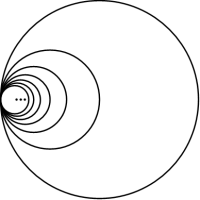This post is Part II in an explanation of why the fundamental group of the earring space is not a free group. I’ll be referencing the notation and results that we worked through in Part I.
Recall that the earring group is an uncountable group isomorphic to the free
-product of
, denoted
.
Theorem 1 (de Smit [1]): is not isomorphic to a free group.
Proof. Since is uncountable (we proved this fact in this post), if it were free, then it would be isomorphic to a free group
on an uncountable set
. But the set of group homomorphisms
to the additive group of integers is in bijective correspondence with the (obviously uncountable) set
of functions
. However, according to Theorem 7 (which we prove below),
is isomorphic to the direct sum
, which is countable. Therefore, we can conclude that
is not a free group.
.
To fill in the remaining gaps (namely a proof of Theorem 7), we’ll need a couple of lemmas to break it up into more manageable bits.
Let be the subgroup of
consisting of sequences
in which the letters
do not appear. Formally,
The elements of were also used in Lemma 3 in Part I.
Lemma 5: For each , the group
is the free product of the subgroup
and
Proof. Since the sets of letters and
used in the two groups are mutually exclusive we can use the uniqueness of reduced words in free groups to prove this lemma. In particular, we need to show that any element of
can be written uniquely as a product
where
and
(where at most one of
or
is allowed to be the identity).
Fix an element . By definition,
for all
. In particular, for
, there is a
such that
for all
. Let
. Thus the appearances of the letters
do not change in the words
. Rather, we can only get
from
by adding letters
(where
) in between the already present elements of
. So by the uniqueness of reduced words in free groups, there are elements
and
such that . We can demand that at most one of
or
may be an identity element. Let
be the projection when
. Then if
we get the desired, unique representation .
Lemma 6: Every homomorphism such that
for all
is the trivial homomorphism.
Proof. Suppose for all
and that
for some
. By Lemma 5, we can (for each
) write
where
and
. Let
. Basically,
is the unique word obtained from
by deleting all appearances of the letters
. Notice that since
, we have
and thus
for each
.
The sequence meets the two conditions necessary to apply Lemma 3 from the previous post. This means there is a self-homomorphism
such that
. But now
is a homomorphism such that
for all
and this contradicts Lemma 4 (again from the previous post) which says that all but finitely many
must be killed by every homomorphism
!
Remark about the proof of Lemma 6: One might be tempted to skip Lemma 5 altogether and try to construct using the self-homomorphism
induced by collapsing the first
circles of
to the identity and leaving the other circles untouched. Indeed, it is true that
, but a priori it is not clear that you get the next step
unless you have the free product decomposition!
Theorem 7: The natural homomorphism given by
is an injection onto the direct sum
.
Proof. Lemma 6 says precisely that is injective so we are left to identify the image. By Lemma 4 from the previous post, for every homomorphism
, there is an
such that
for all
. Thus the image of the homomorphism
lies in the direct sum
. To see that the image is equal to the direct sum take any element
. The natural map
collapsing the
-th circle,
induces a surjection
. Now define a homomorphism
by
. The composition of these to homomorphisms yields the homomorphism
for which we have
when
and
otherwise.
Here is a strengthened version of Lemma 6 that relates this stuff to a non-commutative version of slender groups and suggests that behaves in many ways like the non-commutative analogue of the Specker group
.
Theorem 8: Suppose is any group which has
as a quotient group. For every homomorphism
, there is a
such that
.
Proof. Since we are assuming the existence of a surjective homomorphism , it suffices to prove the theorem for
. Again, we’ll use the fact that there is an
such that
for all
. But notice that the retract
of
consisting of all but the first
circles is homeomorphic to the earring space. Moreover, notice that the image of the inclusion
is precisely
. Since the restriction of
to
takes
to
for all
. So by Lemma 6,
.
I think it is interesting that Theorem 8 applies to all free groups but does not apply when
is any finite group.
References.
[1] B. de Smith, The fundamental group of the Hawaiian earring is not free, International Journal of Algebra and Computation Vol. 2, No. 1 (1992), 33-37.


Pingback: The harmonic archipelago group is not free | Wild Topology
Pingback: The Griffiths Twin Cone | Wild Topology
Pingback: The Baer-Specker Group | Wild Topology
Pingback: The Hawaiian Earring Group is not Free (Part I) | Wild Topology
Pingback: The earring group is not free (Part I) | Wild Topology